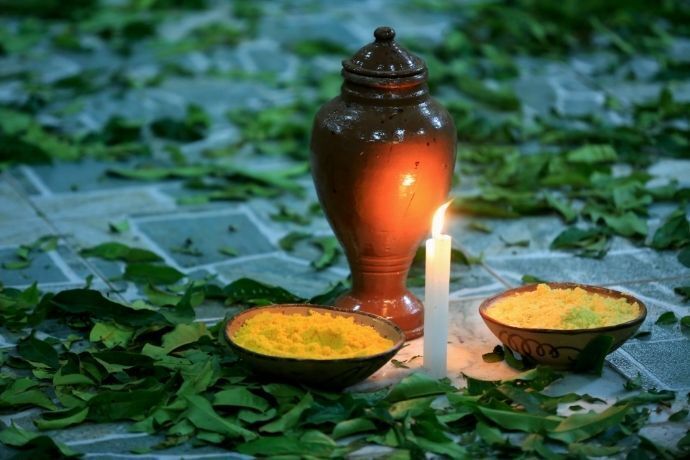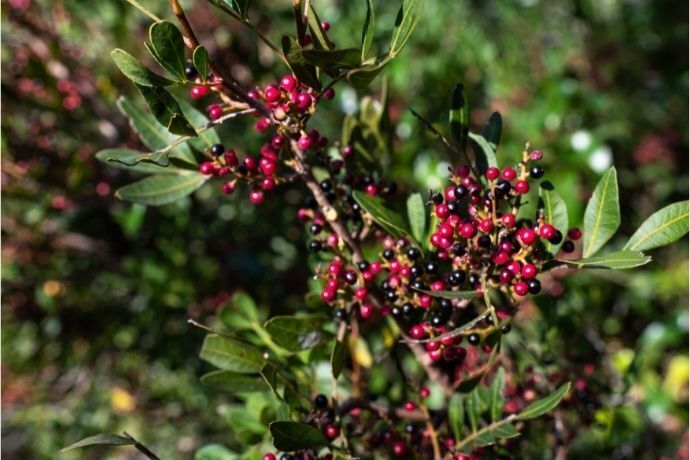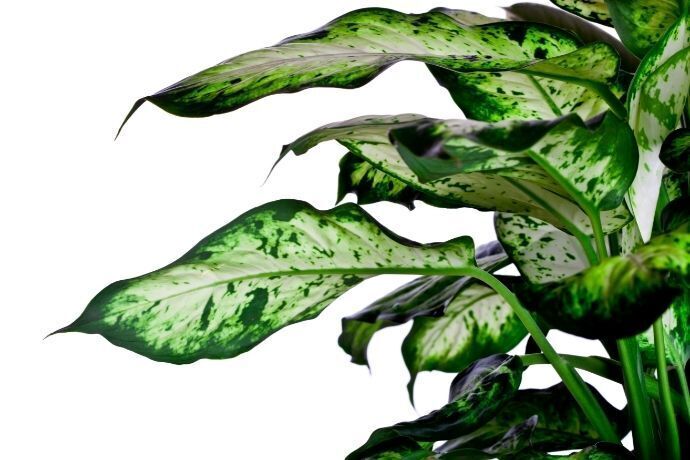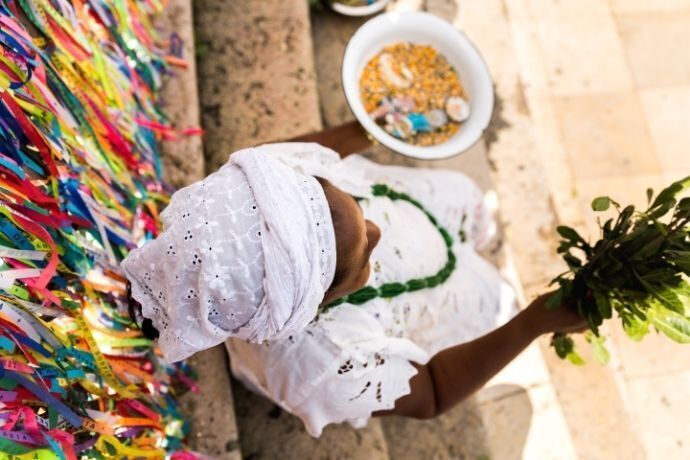Table of contents
Know the leaves and herbs of Ogum!

Leaves and herbs are used in rituals, offerings, spells and other types of spiritual work since ancient times in various beliefs. With Umbanda and Candomblé it is no different, various types of plants are also used for certain purposes.
Each leaf, each herb, each flower, each type of plant has its meanings and its energetic vibrations that help in certain ways of life as prosperity, love, protection, among others. For each purpose there is a plant and a way to prepare it.
The use of plants for energetic work requires a good knowledge about each one before using all, the ideal is to avoid using them in rituals without the guidance of a trusted father or mother of saint. Read this article to know everything about the leaves and herbs of Ogum, the history of this Orixá, how to use the plants correctly and more!
Understanding more about the leaves and herbs of Ogum

To know how to use the leaves and herbs of Ogum in any offering, you need to know the meanings of each one, in addition to knowing about the history of this Orixá and what pleases him. Therefore, read the following topics and understand more about the leaves and herbs of Ogum before performing any pleasure or ritual.
Origin and history of Ogum
In both Umbanda and Candomblé, Ogum is the lord of war and the one who executes the divine laws, being the Orixá closest to human beings, along with Exú. He has his human origin, tending to impulsiveness and working for his father as a warrior in the kingdom of Ifé, fighting endlessly with any enemy that challenged him.
One day he was asked to go into a battle with no end date and asked his son to dedicate one day in the year in his name while in battle that all the people fast and be silent. However, this battle lasted seven years, and when he returned home hungry, he asked for food in several houses, but no one attended to him.
Ogum was so enraged by the lack of consideration that he decimated the entire village with his sword, stopping only with the help of his son and Exú. Then he reminded his father of the request he had made before going into battle, and, feeling remorseful, the mighty warrior dug a hole in the ground with his sword, burying himself standing up.
Ogum syncretism
In syncretism, Ogum is associated with Saint George, the Warrior Saint worshipped in the Catholic religion and celebrated on the same day as the Orixá, which is April 23rd. Although the two are the same entity, there were changes in the history and physical characteristics when being sanctified in Catholicism to attract more people to the religion.
While Ogum is the lord of war and who passed his knowledge to mankind, Saint George is described as the warrior of the Army of God and protector of the soldiers who fought against a dragon and other beings of darkness on his white horse to defend the Kingdom of Heaven.
What is the importance of leaves and herbs for the Orixás?
The energy of each leaf and each herb is different, each one has its vibration, attracting health, protection, prosperity, among other things. Just as it has healing effects on the physical body, being used in cleansing baths, love, prosperity, in specific foods, in offerings, smokings or burnings.
The energy of the plants also vibrates in the same range as the Orixás, therefore, some specific herbs must be used in rituals of certain entities, most of them being cultivated in the own terrain of the terreiro or barracão. As the entities are connected to nature, they also express themselves through the leaves.
What are the most used herbs in Umbanda?
Among the various types of herbs and plants that exist, some are more commonly used within Umbanda, such as arruda, rosemary, lavender, espada-de-São-Jorge, guinea, basil, laurel, eucalyptus, chamomile, sunflower, bamboo, pomegranate and sugar cane. These herbs are also used in Candomblé and it is common to see some being used in cleansing baths and to open paths.
How are herbs classified?
Within Umbanda, the herbs are classified as aggressive or hot, which serve to perform a deep energetic cleansing. The excessive use of these plants can cause an imbalance in the aura and energetic field, such as losna, arruda, guiné, aroeira, peregun, camphor, smoke, among others.
The warm or balanced plants are those that rebalance the person's energy, especially if those classified as hot cause an energy imbalance. Some warm plants are: mango leaf, rosemary, lavender, sage, calendula, levante, basil, chamomile, fennel and mint.
There are also cold herbs, which have specific characteristics and use, usually the handling is guided by the entity or by the mother and father of saint. In addition, they can be classified according to their purpose, as cleaning herb, protection, prosperity and others.
Some cold attractive herbs are: red rose, artemisia, cinnamon, mallow, apple and clove, while the energetic ones are sunflower, jurubeba, coffee leaf and guarana. The calming ones are: lemon balm, passion fruit, melissa, valerian, peach and pineapple.
How to please the Orixá Ogum?
Before performing any offering or work with an Orixá, you must have the guidance of a mother or father of saint of Umbanda or Candomblé, since they have the knowledge about how to work with these entities, what you can or cannot do and what you can or cannot use.
For those who want to make a simpler offering, regardless of the reason, you can light a white, blue or red candle, putting together a liquor wine, beer, and some carnations (flowers). All items should be placed in a field, path or crossroads.
If you want to make a more elaborate offering, but it is still easy, you can prepare a Paliteiro de Ogum, starting the preparation with positive and elevated thoughts. When it is finished, deliver it under a tree or on a train track with a blue candle lit next to it for 7 days.
Ingredients:
- 1 cará or 1 yam;
- 1 package of mario sticks (or toothpicks);
- Bee honey;
- Palm oil.
How to Prepare
Start by cooking the cará or yam with the skin until it is very soft, remove from the heat and let it cool, carefully removing the skin when cold. Place the cará or yam in a bowl and spread some toothpicks over the surface of the food, sprinkling with honey and dende oil to finish.
Main Ogum leaves and herbs

There is a wide variety of leaves and herbs that are related to Ogum, being used in rituals, baths and other purposes within the Afro religions. See below all the plants that are of this Orixá, for which purposes they serve and what are their benefits.
Açoita-cavalo or Ivitinga
This herb is used in unloading baths, sacudimentos (deeper spiritual cleansing and of great effectiveness) and obligations, both inside and outside the temple. It is also used in smokings and the color of its energy is white.
In health, it helps to control diarrhea, to heal wounds, bronchitis, ulcers, laryngitis and to treat rheumatism, besides cleansing the blood and improving vaginal flow. It has anti-inflammatory, antimicrobial, antidiarrheal, antipyretic, depurative and astringent properties.
Ragged lily or Hemlock onion
Popularly known as Cebola-Cencém, the Açucena-rajada is an herbaceous plant that has a large bulb and beautiful flowers, being cultivated in Brazil and India. In the Afro religions, the part of the bulb is more used and must be handled properly.
Its bulb is used in rituals and house shaking, mainly for cleaning works, discovering falsehoods and finding lost objects. When it is used as a medicinal herb, the leaves are boiled as an emollient, eliminating its dryness.
Alevante
Alevante, or Mentha spicata is a herbaceous plant used in alternative medicine, since it is a diuretic, antioxidant, antifungal herb, besides being an insecticide. In the Afro religions, it is considered a powerful herb for cleansing and cleansing baths.
To take a alevante bath, you need to check if you present some of the symptoms: headaches, excessive tiredness, constant yawning without sleep, lack of cheerfulness, lack of initiative, emotional instability, malaise and excessive anger and irritation.
Arnica
There are several species of arnica in Brazil, but the real one has European origin. Despite being beneficial to health, the Brazilian arnica should be applied to the skin, because it is toxic, if ingested can cause, vomiting, cardiac arrhythmia and miscarriage.
The arnica is used in head obligations, ceremonies and abôs (baths) of purification, strengthening, protection and balance of energies. Some works use this herb to bring back the vitality of the individual and return to have their feet on the ground.
Aroeira
The mastic is a small tree with dark red bark and yellowish green leaves that can reach up to 8 meters in height. This plant is used as an astringent, it cures wounds, ulcers, cystitis, coughs, toothache and heals the genital area.
In rituals and works, it is used to prepare baths of unburdening, head obligations, smoking against astral larvae and cleaning crystals and amulets.
Monkey cane
Cana-de-macaco, or cana-do-brejo, is a medicinal plant used in gardening and can be found in the Amazon region. It has anti-inflammatory, diuretic, tonic and astringent properties, helping in the treatment of kidney and menstrual problems.
This herb is used to prepare baths for protection, unburdening and cleansing, as well as for washing beads. The children of Ogum need to take some daily doses of the tea of cana-de-macaco in their abôs, always after lunch and dinner.
Comigo-nuém-pode
Just by the name you can already tell that this is a toxic plant, however, very efficient in spiritual works and against the evil eye. It is recommended that you do not purchase one if you have small children or pets at home to avoid problems.
It acts energetically and spiritually in its natural state, without being placed in preparations of baths or teas. It is usually placed in ornaments or planted in a vase near the entrance door to absorb negative energies from visitors.
Dracena-rajasada or Peregun-rajado
The Dracena-rajada, or Peregun-rajado, is a plant of warm classification, that is, it strengthens, readapts, recalibrates, directs and conducts energies. Moreover, this plant is easily found in candomblé centers.
Its leaves are used in shaking, bathing and rituals, for example at the end of the 17 days of initiation into the religion. It can also be planted around an Ogum house, forming a living fence and replacing ritualistic objects.
Crabgrass
The erva-tostão is a native plant of Brazil and all its parts are used in medicine to relieve pain, fight liver problems, reduce nervousness and improve kidney function.
Its energetic properties are used in the preparation of baths to discharge and remove eguns, using only the leaves. Because it is a plant that makes the bath of discharge very strong, should not be taken in short periods of time to avoid allergies.
St. George's Sword
The sword of St. George is a plant of African origin, toxic and widely used in Afro-Brazilian religions and is commonly found at the front door of a house. It is powerful to bring protection and combat negative energies.
For the sword of St. George protect your home and its residents, should not be placed anywhere, avoid placing it in corners of walls, leave it in a place where it can get sunlight.
Estrela-de-Ogum or Coroa-de-Ogum
The star-of-Ogum or crown-of-Ogum is a variation of the sword-of-São-Jorge, a Sansevieria, however, this one grows forming a crown or a star of 10cm to 15cm of height. Its color is dark green with yellowish stripes resembling scratches.
In Afro-Brazilian religions, this plant is used to border flowerbeds to bring protection, ward off negative energies, protective baths and shaking. Although it is powerful in energetic matters, it has no medicinal use.
Mango leaves
The mango leaves are used in baths of discharge, which should be prepared when necessary, especially when you notice excessive fatigue, or frequent malaise. When playing by the body, pour from the neck down, keeping positive thoughts.
Other symptoms that show the need for the preparation of this bath are constant back pain, legs, emotional instability, excessive anger and lack of spirit. The bath with mango leaves cleanses all the load of negative energy in the body.
Grumixameira
The small fruit of the grumixameira can be eaten raw, in jams, syrups, sweets, ice cream, among other desserts. Its leaves have therapeutic and antioxidant properties, preventing premature aging and avoiding other diseases.
This plant is rich in vitamin C, B1, B2 and flavonoids, it is astringent, anti-inflammatory, diuretic, aromatic and energizing. In religious use, you can cook the leaves to make aromatic baths to cure rheumatism and fatigue.
Heliconia
Being a close relative of the banana trees, from the Heliconiaceae family, the leaves of the heliconia are similar in appearance to those of this tree, and can reach up to 3 meters in height. It is widely used in decorative gardens.
In health, the use of this plant cooked in hot baths is effective against rheumatism. In ritualistic works, it is used in abô de ori, feitura de santo and cleansing baths, discharge and purification of the children of Ogum.
Yellow jackfruit
The Jambo-amarelo is the sweetest fruit of its variation, rich in antioxidants, vitamins A, B1, B2, potassium, zinc and magnesium, being a great diuretic. The jambu herb, typical of the northern region of Brazil, is served in salads.
Its leaves are used in the preparation of baths for the children of Ogum, while the herb is used in head obligations and abô. For those who wish to lose weight, the jambo-amarelo is a good slimming agent in the form of tea.
Red Jamboree
This fruit has several health benefits, preventing chronic diseases, and being rich in vitamins A, B1 and B12, besides calcium, anthocyanins, iron, phosphorus and other minerals. Its leaves are good against diabetes.
Other health benefits are that it is a good anti-inflammatory and helps prevent obesity. It is used in preparations of cleansing baths and amacis (rituals dedicated to one or more Orixás in particular).
Lança-de-Ogum
The spear-of-Ogum, or lance-of-São Jorge, is a cylindrical plant, erect and smooth, dark green in color with light green streaks, resembling a spear. This plant is also placed near the entrance doors of houses for protection.
As it cannot be ingested because it is toxic, the spear-of-Ogum is used in protective baths against dense energies, envy and bad thoughts. It is also used in baths to open paths and achieve goals.
Lemon
The wild lemon has several health benefits, being indicated to treat gastric and respiratory problems such as bronchitis, dry cough, laryngitis, gas, menstrual cramps, among others. For this, you should take 4 cups of the tea a day.
Besides the tea to cure respiratory problems and chronic coughs, its leaves are used in ori and abô obligations, as well as in the preparation of purification baths for the children of Ogum.
Losna
Also known as wormwood, wormwood is a medicinal plant used in the treatment of fevers and helps in the treatment against worms because it is a natural vermifuge. In addition, it is anti-inflammatory and tonic, being good for other treatments.
It is normally used in the preparation of cleansing baths and unburdening of the children of Ogum and to energetically purify environments. It is also used in abô, to increase spiritual perception and rebalance the energies.
Pardo oil
The oil-pardo is an anti-inflammatory and healing herb, being great to be applied on dermatitis and small lesions, besides its root, when cooked, helps in the treatment of ulcers and worms in animals. Its leaves must be used only for discharge baths.
Pau-roxo
The Pau-roxo is a tree with a straight cylindrical trunk, which can be 40 to 60cm in diameter, while it can grow 15 to 25 meters high. Its wood is used for making clubs, cabinetmaking and building bridges.
Only its leaves, which are aromatic, are used in medicine as a balsam. In ritualistic and spiritual works, they are placed in the preparation of purification baths for the children of Ogum, in abô and head obligations.
Pau-santo
Holywood is known for being one of the most fragrant woods on the planet, possessing a pine, mint and lemon aroma. It has been used as a natural incense in the form of bark or powder since ancient times because of its aromatic properties.
It is very common in various religious currents to use pau-santo as a blocker of negative energies and eguns, in Afro-Brazilian religions. In medicine, the tea acts against diarrhea and fever, besides being a good cicatrizing agent.
Piripiri
The leaves and stem of this plant are used to make mats and cellulose, as its fibre is similar to flax. The powder of the dried and burnt stem has medicinal properties to stop haemorrhages.
This powder can also be mixed in a glass with water and sugar and ingested to fight diarrhea. In ritualistic works, chili has energetic properties only for unloading baths.
Porangaba
For those who want to lose weight, the porongaba tea helps the process by having diuretic properties. It is a great detox that serves to remove toxins from the blood, besides improving blood circulation and controlling cholesterol levels.
This serves to avoid heart problems and can be used as a tonic, besides being an antioxidant. The herb is used in baths of unburdening, in various obligations, in abô and sacudimentos, which can be personal or home.
Demand breaker
Originally from India and can reach up to 1.5m in height, this plant grows on the branches of other trees and shrubs without curling up. It needs a lot of sun and should stay in warm and humid climates.
This herb is used to prepare cleansing baths and smokings against negative and dense energies. In addition, it also serves to open the ways, bringing more luck and prosperity in the life of the individual.
Dragonblood
This plant has varied medicinal properties such as healing, antioxidant, antimicrobial, anti-inflammatory, oral analgesic and antidiarrheal. Although it is good for health, it cannot be consumed too much as it can cause anemia or blindness in extreme cases.
In ritualistic and spiritual works, the dragon's blood is applied in head obligations, abô, incenses, purification baths and descargo. In addition, its juice can be used as a dye.
Tanchagem or Trançagem
Plantain is an easy plant to grow and can reach up to 50cm in height, while its large leaves grow horizontally close to the ground. It has antimicrobial, anti-inflammatory and analgesic properties, being excellent in curing mumps.
Its leaves are rich in calcium, minerals and vitamins, and are eaten fresh in salads or sautéed when they are older. Plantain is used for head obligations, abôs, purification baths and for the settlement of the Orixá Ogum.
Church Broom
The broom is a small herb where small delicate white flowers grow. Unfortunately it has no use in folk medicine, but the bath of this herb can serve for urinary tract infections and fluid retention.
In the spiritual and energetic treatment, it is applied in shaking and is used for the "descargo" baths, in the help to increase self-confidence and in the decision process of tasks and responsibilities. It is not recommended to ingest this herb because it is toxic.
How to use the Ogum plants?

As can be seen in this article, there are several types of herbs and plants that are ruled by the Orixá Ogum and can be applied in various types of works, rituals, spells or energetic and spiritual treatments. Some are beneficial both energetically and for healing pain, viruses or diseases.
Ogum plants should be prepared and used according to their purpose, whether it is for a bath of unburdening, cleansing bath, for smoking, as incense, for rituals, offerings or home remedies. Depending on what it will be used for, it can be prepared macerated, boiled or burned.
Although you can use these herbs and plants at home for baths, incense, medicine or salads, be sure to seek medical advice first. If you want to do a ritual or other specific spiritual work, you must have the guidance of a mother or father of saint for everything to go smoothly.

